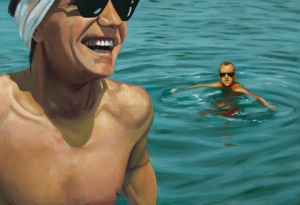Vol ‘n’ Tell is an ongoing series of blog posts written by RMG Volunteers. Raechel Bonomo is an Oshawa native, art enthusiast and second-year Print Journalism student at Durham College.
As you walk into Gallery A, the new community art space at the Robert McLaughlin Gallery in Oshawa, you are greeted by the scent of fresh paint as your eyes wander across the brightly colours where paint is not only on the canvas but spilled off and onto the walls.
A concept carried out by artist Pete Smith and a literal out-of-the-box interpretation of what this new space hopes to bring Oshawa.
In the last two years, community art studios or “art hives” have been emerging across Oshawa. The concept of public-based art is reinforced by city initiatives such as Culture Counts, an arts, culture and heritage plan introduced last year.
On a larger scale, the RMG has recently hopped on the community art studio bandwagon.
Elizabeth Sweeny is the manager of public programs and art reach at the RMG. She says the RMG surveyed more than 100 people in the Durham Region regarding art-based community development and found a high demand for a professional space to display art.
Gallery A is the answer to that call.
Opened early this year, Gallery A is a professional exhibition and studio space in the lower level of RMG intended to offer opportunities for artists in the community to share their work. The space also plans to provide educational opportunities to community members including information sessions and technique classes.
“Durham Region is full of culture and we are certainly building on that. We know that artists need more spaces to exhibit, so absolutely it’s helping to address that void,” says Sweeney.
Among these spaces is The Vault, or the V3 Collective, located in downtown Oshawa.
The Vault is a volunteer run space where artists and community members can make, display, and buy art. The owner of the space, Zal Press, believes in the concept of local art and as an economic catalyst.
“If you look back, economic growth and prosperity is grown by the creative class,” he says. “It’s not only the growth but it’s resilience, the capacity to change with time.”
Press considers Queen Street West in Toronto, where he resides, as a respectable model for Oshawa to follow.
He credits Toronto artists for the popularization and economic drive in the area. They were able to draw attention to areas with local art, creating a buzz loud enough to capture the attention of city. Wherever the artists were, development came.
According to Press, development occurred along Queen Street West wherever artists such as visual, performers and musicians occupied. For example in the 80’s, Spadina and Queen used to be an area populated by artists until it was developed into a shopping hub.
“Follow the artists and you’ll find the money,” says Press.
This economic model and new wave of thinking can be rooted to The Rise Of The Creative Class: And How It’s Transforming Work, Leisure, Community And Everyday Life written by Richard Florida. It promotes the vitality of out-of-the-box thinkers to create a sustainable economic environment, specifically in cities.
In Oshawa, art and art studios are being used as a both a tourist attraction and a reason to bring residents downtown.
Steven Frank put this idea into action in 2012 when he created Oshawa Space Invaders (OSI), an art crawl that occupies vacant buildings in the downtown area.
“It helps show the potential in individual spaces that may end up being leased as a direct result of our exposure,” says Frank.
Not only does this idea engage local artists, 200 participants in 2014, to display their work as well as art appreciation from community members, it serves as an economic driver for downtown businesses. The foot traffic during OSI last year brought more than 5,000 visitors downtown.
“By creating an event that brings together the creative community in an innovative way we help people envision the downtown as a place of vitality, worthy of investing in,” says Frank.
In the last year, even more community art hives have developed in Oshawa’s downtown.
The Livingroom Community Art Studio began as an idea in the head of Mary Kronhert in 2007 while she was studying to be an art therapist in Toronto. Derived from an article from Concordia professor and owner of La Ruche D’Art in Montreal, Janis Timm Bottos, Krohnert was introduced to the concept of a free, community space where members of the public could walk in and make art.
“Art spaces like this tend to revitalize neighbourhoods and make the areas around them more colourful,” says Krohnert.
A $38,000 Ontario Trillium Grant was used to pay for rent, materials and one part-time staff member, made the Livingroom studio possible. Krohnert also relies on community donations to keep the studio afloat, a call well received by the public that has filled the studio with paint, fabric and even some musical instruments. The walls of the studio are lined with buttons, paper, pipe cleaners, the epitome of any crafter’s heaven.
Despite only being open for a couple of months, the studio has been well received by the community. According to Krohnert, studio attendance has been high with new and returning walking through the door every day.
“There’s nowhere else like it,” says Krohnert. “This is something Oshawa needs.”
Together the creative class is helping to evolve Oshawa to create a more viable, economically strong city – one art hive at a time.
Image- Postscript, Pete Smith, 2015.







